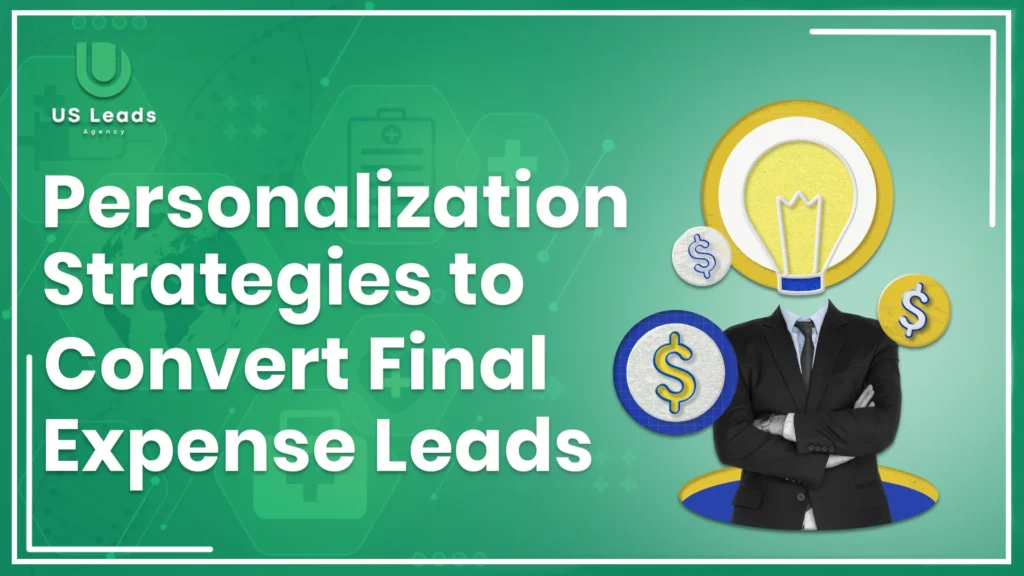
Personalization strategies to convert with final expense leads can significantly improve your chances of converting potential clients into customers. Final expense insurance is a sensitive subject, as it deals with funeral costs and other end-of-life expenses. Many leads you’ll encounter are seniors or individuals nearing retirement who may have specific concerns or hesitations about their future. To resonate with them, it’s important to tailor your outreach, build trust, and address their unique needs.
Key Takeaways:
Understand your audience’s needs and motivations to craft personalized, empathetic conversations that resonate.
Build trust by listening actively and communicating transparently, creating a foundation for long-term relationships.
Use data to segment leads, allowing for more targeted outreach based on their specific circumstances.
Personalize your marketing materials across different channels to better address individual concerns.
Incorporate storytelling into your sales pitches to make the benefits of final expense insurance more relatable and compelling.
Offer tailored solutions that consider the unique financial situations of each lead, providing flexibility and value.
Here’s how you can effectively personalize your approach with final expense leads:
Personalization Strategies For Final Expense Leads You Must Know:
1. Understand Your Audience:
The first step in personalization strategies is to convert final expense leads by understanding who you are talking to. Final expense leads are often individuals aged 50 and above, and they have unique financial concerns compared to younger generations. Many are worried about leaving a financial burden on their loved ones when they pass. By empathizing with their concerns and offering solutions that align with their values, you can make your interactions more personal.
- Research their demographics: Understand their age, income, and health status to tailor your pitch.
- Learn their motivations: For some, it’s about ensuring their family isn’t burdened with costs; for others, it’s about leaving a legacy.
2. Build Trust Through Communication:
Since final expense insurance deals with sensitive topics, trust is paramount. Leads are more likely to choose an agent they trust, so focus on building rapport in every conversation.
- Listen actively: Instead of immediately selling, listen to their concerns and fears. This allows you to craft a response that truly addresses their needs.
- Be transparent: Share clear, easy-to-understand information about premiums, coverage, and benefits. Avoid confusing jargon or making the process seem more complicated than it is.
- Follow up with empathy: Periodic follow-ups that don’t feel pushy help nurture relationships over time.
3. Leverage Data to Segment Leads:
A one-size-fits-all approach doesn’t work for final expense leads. Use data to segment your leads into specific groups based on factors like age, health status, or financial situation. This allows you to create targeted messaging for each group. For example:
- Healthy seniors: They may be more interested in low-cost plans with quick approval.
- Leads with pre-existing conditions: These individuals might appreciate knowing about guaranteed acceptance plans that don’t require a medical exam.
By personalizing your outreach to their specific circumstances, you increase the chances of converting leads into policyholders.
4. Use a Personalized Touch in Your Marketing:
Your marketing materials, whether digital or print, should speak directly to the concerns of your audience. Personalizing email campaigns, direct mail, and even social media outreach can make a significant difference.
- Personalize email subject lines and content: Instead of generic subject lines, use their first name and specific references to their concerns (e.g., “Worried about final expenses, [Name]? Here’s how we can help”).
- Segmented landing pages: Drive different groups to customized landing pages that speak to their unique needs.
5. Incorporate Storytelling in Sales Pitches:
Storytelling is a powerful tool in sales. When discussing final expense insurance, share stories about clients who faced financial struggles without coverage and how a final expense policy could have made a difference. On the flip side, share success stories where families were relieved of the financial burden because their loved ones had a policy in place.
- Relatable scenarios: Paint pictures that make it easy for leads to see themselves in the story.
- Emotional connection: Stories can evoke emotions, making leads feel understood and motivated to take action.
6. Be Flexible and Offer Tailored Solutions:
Each individual’s financial situation is different, so being flexible with your offers and providing tailored solutions will show that you understand their specific needs. Offering different plan options based on their current financial standing can make the decision easier.
- Highlight affordability: Explain the different payment options available, and emphasize that even low-cost plans can make a big difference.
- Customize policies: Show them how they can tweak policy features to suit their preferences, whether it’s about choosing beneficiaries or funeral arrangements.
Conclusion – Personalization Strategies:
Personalization strategies to convert your approach in final expense leads can lead to better engagement, trust-building, and ultimately, more conversions. By understanding your audience’s needs, building trust, leveraging data for segmentation, and incorporating personalized touches in your marketing, you can set yourself apart from competitors and provide a valuable service to your leads. Remember that this process is more about offering peace of mind than selling a product—when you approach leads with empathy and tailored solutions, you create lasting relationships that benefit both your clients and your business.
By implementing these strategies, you’ll be able to create meaningful connections and improve your conversion rates with final expense leads.
